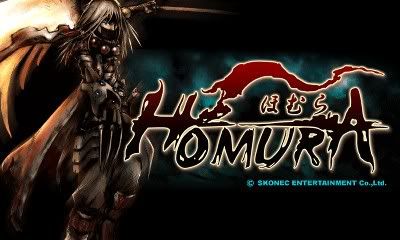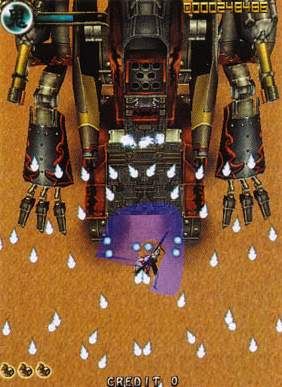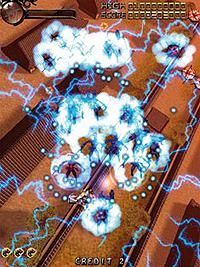
Game: Homura
Developer: Skonec
Publisher: Taito
Release Date: December 5th, 2005
Genre: Shooting
System: Playstation 2
Here is something you don't see everyday: a Korean-developed game that is set in historic Japan. The Korean developer, Skonec, is responsible for ports of Psyvariar and Shikigami no Shiro III, as well as Korea-only DS software. Homura was their 3rd attempt at a shmup. This is not a spaceship or aircraft shmup, but a flying human shmup like seen in Espgaluda, Sengoku Blade, among others.
The story is that a forbidden jewel was stolen by a monster. After the monster stole the jewel, he gave it to real-life Japanese warlord, Ieyasu Tokugawa (Who hired the monster to steal it). The jewel gave Tokugawa powers and he was able to invade Osaka castle. A group who also wants the jewel banded together to steal the jewel from Tokugawa. The group's leader, Shoshi Tenyu, wants to use the ever-powerful half human, half monster Homura, to get the jewel. Some members oppose using Homura to get the jewel, but he is the only person who can do this job. The reason being is that Homura cannot be influenced by the jewel's evil power because of his bloodline. Homura, who was in prison, was asked by Shoshi Tenyu to help get the jewel. Homura initially refused, but later changed his mind because heard the people in Osaka Castle were all killed by Tokugawa, including Homura's mother. Driven to revenge, Homura has drawn his sword with only one thing in mind: cutting off Tokugawa's head. It's on

Make no mistake, this is a danmaku (bullet hell) shmup. The bullet patterns are not as intricate as the ones in Cave games, but they are often creative. Many bullet patterns form shapes relevant to Japanese culture such as manjis and sakuras. The hit box is very small so that means a lot of very precise bullet-dodging will be necessary for survival. The retro-futuristic enemies make the game feel stylish and unique.
Like most shmups, you are given a regular shot and a bomb. The shot can be powered-up, and the bomb annihilates everything on the screen. It's pretty straightforward. The unique aspect of this game are the two different "Battou" attacks. Battou, which means "drawn sword", allows Homura to execute a one-hit-kill close range rush attack to every enemy on the scree. The other Battou attack deflects enemy bullets if you are ever in a tight spot. There is a Battou meter in the upper-left corner of the screen. Which Battou attack Homura executes depends on what is going on in the game. If you have any enemy in close range, Homura will perform the rush attack in which he zig-zags across the screen slashing all in his way. The other Battou attack occurs when Homura is surrounded by enemy bullets which are then deflected back at the enemy.

As you kill enemies, you can collect "chikara" icons. As you collect these icons you build up a power meter (located to the right of the Battou meter). Every time the power meter hits its limit, you are given an additional "option". These "options" are similar to options from Gradius games; pulsating orbs that give you more firepower. You can have a limit of four "options". If an enemy is killed with a Battou attack, Chikara icons are drawn to you as if you're a magnet. Kill an ememy with a shot or a bomb, and you'll have to make an effort to collect it.
There are 4 stages in the regular game, but if you clear the first 4 stages without continuing, you will be introduced to a 5th stage where you can meet the true last boss. Halfway through each stage you can choose a path. Left, or right. With a lot of combinations, the game will be slightly different each time you play it as long as you don't always choose the same paths.

Grievances:
The audio bugs in the game are a reminder that this game might have been rushed or made by a novice developer. No game is perfect, but there are bugs that seem a little amateur. Perhaps that is the reason behind the doujin feel of this game. I love doujin games...when they are done right.
The backgrounds are not very nice and somewhat bland. There are some really nice backgrounds, such as the boss of level 2, but for the most part things could be greatly improved.
Praises:
The Battou system is really cool and unique for a shmup. It is always very satisfying to see Homura rush across the screen, killing all in his way.
The historical Japanese Warring States (Sengoku Jidai) backdrop, while not original, is a fresh breath of air from traditional spaceship shooting games. The retro-futuristic enemies make the game feel stylish and unique.
Selectable routes mid-level gives the game variety and replay value.
Offers a great challenge by only giving you 3 credits, but every time you use all credits, you are given an extra credit when you start a new game. You have to work for your credits if you want to beat the game by having the game beat you, first.
The Verdict: 7.0
Homura is a lesser-known shmup that holds its own among a sea of ho-hum space shooters. Think of Homura as a vertical version of the Sengoku blade games. There is great replay value and the game encourages you to keep coming back until you can clear it with one credit. It will reward you for doing so. There really isn't much information about this game other than what's in the manual. Again, this game is a lesser-known shmup, but it is worth playing if you're a fan of the genre.

No backups or emus, my copy:


No comments:
Post a Comment